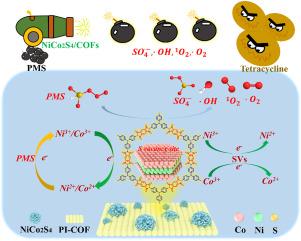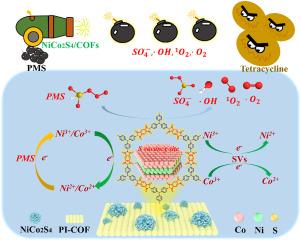Activation of peroxymonosulfate by NiCo2S4/covalent organic framework composites for the degradation of organic pollutants: Catalytic performance and mechanism
IF 10
1区 环境科学与生态学
Q1 ENGINEERING, ENVIRONMENTAL
引用次数: 0
Abstract
The peroxymonosulfate (PMS)-based advanced oxidation process has attracted considerable interest in the degradation of refractory pollutants owing to the potent oxidative ability and outstanding degradation performance. However, the development of high-performance catalysts remains a key challenge for achieving efficient PMS activation. In this work, polyimide-based covalent organic framework (PI-COF) is designed to support cobalt spinel oxides (NiCo2S4) for activating PMS in the efficient degradation of organic pollutants. The NiCo2S4/COFs composites show high catalytic activity due to the redox processes of Ni3+/Ni2+, Co3+/Co2+, S2−/S22−/S0/Sn2−/SO42− and the electron transfer of sulfur vacancies (SVs) induced by the introduction of NiCo2S4 on PI-COF. The NiCo2S4/COFs composites also possess good applicability for diverse antibiotics and dyes and robust stability over 7 cycles. The activation mechanism study manifests that 1O2, and are the leading reactive oxygen species (ROS). The probable degradation pathway is concluded via identifying intermediate compounds, and computational toxicity evaluation demonstrates the lower ecotoxicity of intermediates. This work presents a novel strategy for degrading aqueous organic pollutants through PMS activation.


NiCo2S4/共价有机骨架复合材料活化过氧单硫酸盐降解有机污染物:催化性能及机理
基于过氧单硫酸盐(PMS)的高级氧化工艺由于其强大的氧化能力和优异的降解性能而引起了人们对难降解污染物的广泛关注。然而,高性能催化剂的开发仍然是实现高效PMS活化的关键挑战。在这项工作中,聚酰亚胺基共价有机框架(PI-COF)被设计用于支持钴尖晶石氧化物(NiCo2S4),以激活PMS有效降解有机污染物。NiCo2S4/COFs复合材料由于Ni3+/Ni2+、Co3+/Co2+、S2−/S22−/S0/Sn2−/SO42−的氧化还原过程以及NiCo2S4在PI-COF上引起的硫空位(SVs)的电子转移而表现出较高的催化活性。NiCo2S4/COFs复合材料对多种抗生素和染料具有良好的适用性,并且在7次循环中具有很强的稳定性。活化机理研究表明,1O2、O2·‐O2·‐和SO4·‐是主要活性氧(ROS)。通过鉴定中间体化合物,得出了可能的降解途径,计算毒性评价表明中间体的生态毒性较低。本研究提出了一种通过PMS活化降解水性有机污染物的新策略。
本文章由计算机程序翻译,如有差异,请以英文原文为准。
求助全文
约1分钟内获得全文
求助全文
来源期刊

Journal of Cleaner Production
环境科学-工程:环境
CiteScore
20.40
自引率
9.00%
发文量
4720
审稿时长
111 days
期刊介绍:
The Journal of Cleaner Production is an international, transdisciplinary journal that addresses and discusses theoretical and practical Cleaner Production, Environmental, and Sustainability issues. It aims to help societies become more sustainable by focusing on the concept of 'Cleaner Production', which aims at preventing waste production and increasing efficiencies in energy, water, resources, and human capital use. The journal serves as a platform for corporations, governments, education institutions, regions, and societies to engage in discussions and research related to Cleaner Production, environmental, and sustainability practices.
 求助内容:
求助内容: 应助结果提醒方式:
应助结果提醒方式:


